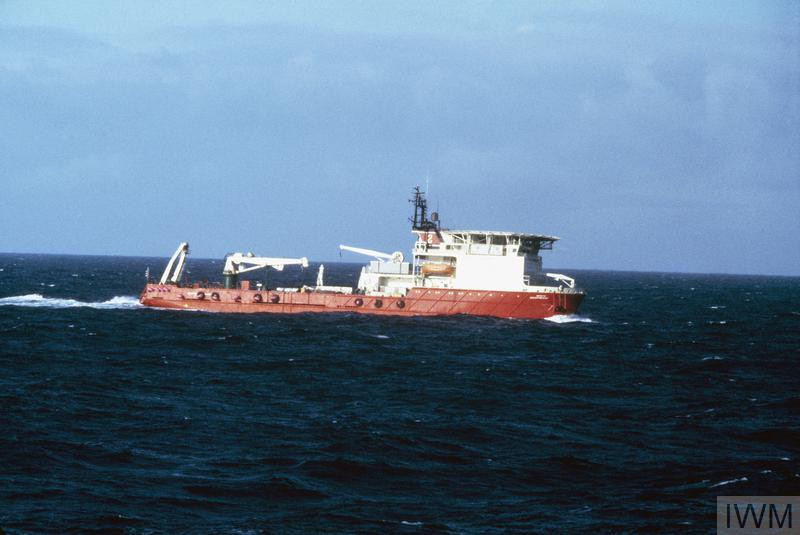Thursday 3 June 1982 was another quiet day in the South Atlantic, allowing a steady, inexorable advance by British troops and their support towards Stanley as the weather played its part once again.
Since its arrival in the Total Exclusion Zone around the Falklands, the Carrier Battle Group had flown Combat Air Patrols whenever possible, the Sea Harriers defending British ships and land formations against air attacks while also striking at Argentine positions, particularly around Stanley.
But there were days when any combination of fog, low cloud, high winds and/or heavy seas made fixed-wing operations all but impossible, and the patrols were halted. That was not necessarily a major problem, because if the Harriers couldn’t get airborne, there was very little chance of the Super Etendards, Daggers and Skyhawks flying in from their bases in Argentina either.
One fixed-wing aircraft that was aloft on 3 June was the RAF’s Vulcan bomber charged with carrying out Operation Black Buck 6, a strike on the Argentine AN/TPS-43 mobile early warning and tactical control radar at Stanley airfield which had been providing vital information on British movements.
But with the Sea Harriers unable to play their part in the raid, radar operators on the ground simply kept the equipment switched off, which mean the RAF’s Shrike missiles had no radar signals to lock on to.
Instead the Vulcan loosed its missiles at radar used to aim anti-aircraft guns around the airfield, thereby achieving some measure of success for the effort expended.
That sense of achievement would have been marred by the fact that the Vulcan’s in-flight refuelling probe was damaged en route, and the aircraft had to divert to Rio de Janeiro in Brazil, where it landed with its tanks running low.
Brazilian officials impounded the bomber and her crew, and only released them when they were given assurances by the British that they would be permanently removed from the conflict.
Two potential flashpoints between the British and Argentinians passed off without any damage being inflicted.
A Lynx helicopter from Leander-class frigate HMS Minerva was scouting the Port Stanley area after Task Group commanders gained intelligence suggesting land-based Exocet missiles were being deployed by Argentine forces.
But a close encounter with a surface-to-air Roland missile brought an early end to the mission – and the intelligence was later proven to have been accurate, as destroyer HMS Glamorgan was to discover just over a week later.
The other encounter was anything but close.
An Argentine Boeing 707 reconnaissance aircraft flew over helicopter support ship RFA Engadine almost 1,000 miles to the north-east of the Falklands on 3 June, but neither ship nor aircraft had the means to engage the other.
Ashore, British forces continued to push forward, the Gurkhas being flown by helicopter to Goose Green, where they took over from 2 Para in patrolling the Lafonia area, while the paratroopers continued to move to their new forward operating base at Fitzroy and Bluff Cove, on the south coast of East Falkland.
MV Nordic Ferry arrived at San Carlos Water on 3 June, carrying equipment, stores and ammunition in support of 5th Infantry Brigade troops, while Canberra finally finished offloading her troops and stores and headed out to the east, spending the rest of the conflict in the TRALA (Tug, Repair And Logistic Area).
Inbound to the Falklands was roll-on, roll-off container ship Contender Bezant, later to join the Royal Fleet Auxiliary permanently as RFA Argus.
The ship sailed from Ascension on 3 June with four RAF Harrier GR3s, two 3 Commando Brigade Air Squadron Gazelle helicopters and an RAF Chinook.
All the while the routine of refuelling and restoring was carrying on in the open ocean and in the vicinity of the Falklands; on 3 June RFA Fort Austin carried out replenishments at sea (RASes) with HMS Invincible, HMS Brilliant, HMS Glamorgan, RFA Fort Grange and RFA Resource, and was then relieved by Fort Grange.
Small Fleet tanker RFA Blue Rover refuelled assault ship HMS Fearless in San Carlos Water, while out in the Atlantic Fleet tanker RFA Plumleaf suffered mechanical problems, but they were soon fixed and she continued to provide ‘motorway service station’ support to ships involved in Operation Corporate.
On the diplomatic front, the G7 Versailles Summit opened in France, with US President Ronald Reagan offering a five-point plan to British Prime Minister Margaret Thatcher – the Falklands Conflict was one of the many talking points addressed by world leaders over the next four days.
Today’s image from the Imperial War Museum collection (© IWM FKD 760) shows repair ship MSV Stena Seaspread in the Total Exclusion Zone around the Falkland Islands. Stena Seaspread was equipped with a heavy machine shop and was a vital component of the Tug, Repair and Logistic Area (TRALA) which was something of a safe haven out to sea.
.
* These posts can only give a brief sense of what was a complex and fast-moving situation 40 years ago, and cannot cover the involvement of every ship, squadron and unit in detail – for a much more comprehensive account see the Falklands section of naval-history.net at https://www.naval-history.net/NAVAL1982FALKLANDS.htm
The Royal Naval Association is the biggest collective group of Royal Naval veterans and serving personnel, with more than 270 branches in the UK and overseas.
The RNA provides those with a link to the Royal Navy access to a life-long community of like-minded and supportive individuals.
Our community provides companionship, resilience, comradeship and unity to anyone and everyone with a Naval story, supporting them through life's highs and lows.
Membership is now free (please note, some branches may charge a small annual subscription, payable locally on their request) – see https://royal-naval-association.co.uk/join-us/ for details of how to join.
